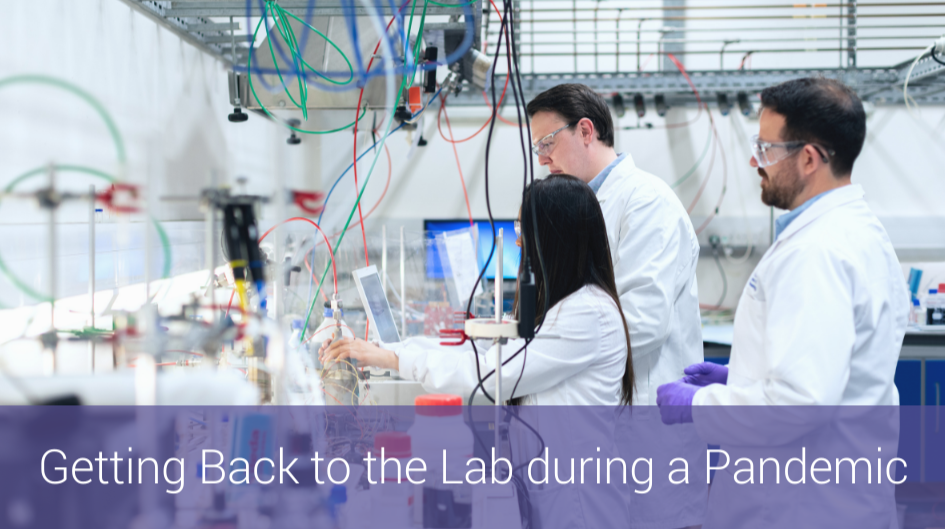Getting Back to the Lab during a Pandemic
Careful planning and lots of social distancing are critical for research labs that have remained open during the COVID-19 pandemic and those looking to reopen.
When the coronavirus first hit, government, industrial, and academic laboratories around the world faced tough operating decisions and had little time to make and implement them. Once the World Health Organization (WHO) upgraded COVID-19 to pandemic status, many research labs shut down, others moved to minimal maintenance, and some kept up full operation but had to implement a string of new measures to protect the safety and health of workers.
In the U.S., the Department of Homeland Security Guidelines designated the chemical sector as essential. Thus, many chemical manufactures, including pharmaceutical companies, remained in operation.
Research labs, however, vary. Some industrial labs kept running on a partial basis but most in government and academia closed – except those doing COVID-19-related work.
Embrace a New Normal
With WHO and other medical organizations expecting the COVID-19 outbreak to drag on for months or even years, all laboratories must now brace for a new normal. Lab directors and researchers must determine when to reopen closed research labs and how to accomplish it safely. They must also figure out what measures to take should the decision to reopen turn out to be premature, and the virus cases resurge.
So far, two things are clear, as tough a decision as it was, but it was far easier to close down research labs than it will be not only to reopen but also find a new normal modus operandi.
What to Consider as You Plan to Reopen
As the world continues to deal with the coronavirus outbreak, research labs are coming up with new plans to reopen and continue operations amid the COVID-19 pandemic. Disease outbreaks are not the only pandemics that could result in staff staying away from their work areas for extended periods. The same could happen after a fire, hurricane, earthquake, tornado, flood, or even a severe blizzard.
So how do research labs go about reopening after a pandemic that forced staff to observe social distancing or work from home for extended periods in isolation and potentially caused a great deal of trauma?
Below are a few considerations to make:
1. Phased Reopening
Research labs will likely bring back their staff in phases and implement staggered work schedules as the hunt for a COVID-19 vaccine continues. In the meantime, lab staff will continue to work from home as leaders and managers turn to disaster preparedness plans to find the most critical functions to prioritize.
2. Social Distancing
Social distancing will become the norm for a while as it’s one of the most effective preventive measures for the coronavirus spread. As such, lab leaders must determine the ratio of their staff that will work from home so that they can implement social distancing at work.
3. Determine Work Schedules
Some groups may reopen their research labs at a reduced capacity and allow only a few team members to the critical on-site functions at a time. These schedules will allow social distancing at the lab and protect all staff members. Pandemics are not fair, so labs must determine what is appropriate when preparing work schedules.
4. Safety
As research labs reopen, they need to give special considerations to the safety of their on-site staff. In this respect, the CDC will be vital in issuing COVID-19 safety guidelines. Labs must also consider things such as:
• Policies to adopt in shared spaces like restrooms and break rooms to ensure social distancing.
• Protecting their staff when it comes to things like door handles (especially in bathrooms) and other shared lab equipment.
• The use of shared computers safely. They could consider adopting policies to protect staff from spreading illness, such as using gloves when handling computers, purchasing washable keyboard covers, or installing special software on individual computers.
5. Disaster Preparedness Plan
All research labs must create and update their disaster preparedness plans regularly, which come in handy during a pandemic. The point of disaster preparedness plans is to ensure a quick recovery once the event passes. With a proper plan in place, research labs should face little trouble when reopening during the COVID-19 pandemic or recovering from a disaster.
6. Identify the Most Critical Functions
If your lab’s leadership had done little to identify the critical functions in advance, then they must make it a priority before reopening. Once you identify these functions, assign the appropriate staff, considering social distancing rules, and share the plan with everybody. Remember to add it to your disaster preparedness plan.
7. Provide Training
Discuss the critical lab functions you have identified with your staff before they return to work. Include everything that they will require moving forward as well as the safety measures you have put in place to allow your team to identify any concerns and needs they have.
Include additional training if necessary to enable your staff to provide support in areas they are unfamiliar with to ensure a smooth reopening. To train your team from home, you can prepare and review COVID-19 preparedness protocols, answer questions, hold webinars, and provide safety information for new procedures.
Research labs can also perform mock run-throughs at home via video conferencing using stand-in items.
8. Team Connection
Enable remote working environments and allow team connections. Renewing a sense of team membership among your staff is essential in building ties and offering help and support. Some of your lab staff may be dealing with tremendous grief, loss, and trauma. Others may be suffering from depression due to isolation and the stress of the COVID-19 pandemic.
Teamwork can be critical in offering emotional support and helping people deal with their home problems. Lab mates can provide coverage for members who need to handle family issues.
The Bottom Line
Research labs that take time to review the above concepts with their staff, and get plans in place to reopen during the COVID-19 pandemic, will allow for a smooth transition back to work.
Infection is a massive driver of the coronavirus outbreak, and social distancing is one of the significant aspects of containment. Therefore, carefully planned disaster preparedness plans and safety measures could be the differentiating factors between a successful reopening and closing down again.
Easing the COVID-19 Reopening Burden
For research labs to operate efficiently and effectively, they require high-performance lab equipment. American BioTech Supply is a leading manufacturer of advanced temperature-controlled equipment for clinical and laboratory research as well as the healthcare and pharmaceutical industries.
The company’s products range from small-capacity countertop refrigerators and freezers to special-purpose cryogenic freezers.
For more information about its products, contact American BioTech Supply today.





